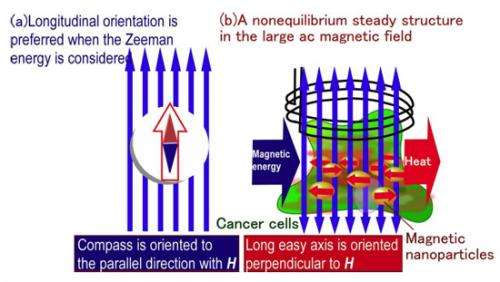Hyperthermia treatment of cancer using magnetic nanoparticles: First detailed elucidation of heat generation mechanism

Dr. Hiroaki Mamiya, a Senior Researcher of the Neutron Scattering Group, Quantum Beam Unit, National Institute for Materials Science, Japan, in collaboration with Prof. Balachandran Jeyadevan of the School of Engineering at the University of Shiga Prefecture have investigated theoretically the mechanism of hyperthermic potentiation of cancers using magnetic nanoparticles, which enables selective heating of hidden micro cancer tissue, and clarified the fact that the nanoparticles under large magnetic fields form unique oriented states, depending respectively on subtle differences in their local environment in the cancer tissue and consequently affect the optimum heating conditions.
Magnetic thermotherapy of cancers has few side effects and active research on this technique, together with immunotherapy, is now in progress as a fourth treatment method, following surgery, radiotherapy, and chemotherapy. In particular, this technique is effective against microcarcinomas that evade detection. In targeted magnetic hyperthermia treatment of cancers, magnetic nanoparticles (nanosized magnets) which act as thermal seeds under an alternating magnetic field are transported to cancer cells using drug delivery technology. However, there are inconsistencies between experimental results and predictions of the amount of heat generated by the magnetic nanoparticles based on the existing simple models, and this has been a major obstacle to optimize the design of magnetic particles for practical application.
Conventionally, the magnetic response of nanoparticles had been calculated using analytical solutions of the models considering magnetostatic energy, where we can imagine a magnetic compass points to the direction of the Earth’s magnetic field. However, Dr. Mamiya’s team carried out a simulation under near-actual conditions, considering the fact that a large amount of heat is dissipated into the surrounding cancerous tissue and found that the oriented state of the magnetic nanoparticles changes dramatically depending on the size and shape of the nanoparticles, the viscosity of their surroundings, and the alternating magnetic field irradiation conditions. Among those conditions, there are cases in which the magnetic nanoparticles align in planes perpendicular to the magnetic field unlike magnetic compass when a high frequency magnetic field with comparatively weak amplitude is irradiated. Furthermore, this research also revealed that the heat generation property of the magnetic nanoparticles largely varies with the change of the steady orientation structure.
Once the knowledge gained in this research is verified and established using an in-situ observation technique employing a quantum beam with high penetrating power, it will be possible to optimize the magnetic thermal seeds and irradiation device for the attributes of the carcinoma being treated. This will be a major advance towards the practical application of hyperthermia treatment of cancers using magnetic nanoparticles.
This research achievement will be announced on November 15, 2011 in the online edition of Scientific Reports, which is an open access journal of the Nature Publishing Group.
Provided by National Institute for Materials Science
















